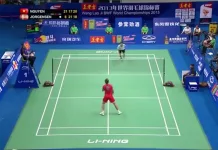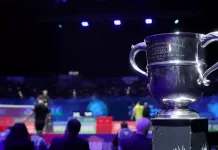
This is an exact transcript of an article in The Field, The Country Gentleman’s Newspaper, from April 8, 1899. The article sums up the preparation going into organizing the first All-England tournament and reviews the matches that took place on April 4, 1899.
One year prior, on 10 March 1898, Guildford Badminton Club organized the first-ever Open Badminton Tournament. This was such as success that the Badminton Association of England decided to organize its own event in April of 1899. Mr. Percy Buckley had been instrumental in organizing the Guildford tournament. The same Mr. Buckley likely also conceived the idea of the first open badminton tournament. In any event, as the President of the Badminton Association, Mr. Percy Buckley was also very much involved in the 1899 tournament in London.
Badmintonspeak.com would like to shed light on the history of the sport of badminton. We believe it is important to know our history and to pay homage to the pioneers who helped shape the sport of badminton.
What follows is an unedited transcript from the newspaper article in The Field
There has been a great revival of the game of Badminton during the last few years, and the Badminton Association, which had been practically lying dormant for the first half of this decade, has received an infusion of new blood of late, which has had the effect of stirring it to a state of healthy activity.

Badminton becoming extremely popular in London (1899)
The game is now extremely popular in the neighbourhood of London, and at the present time, no fewer than nine suburban clubs are affiliated to the Association out of a total list of thirty.
These do not by any means represent the full strength of the clubs in the vicinity of the metropolis; there are, in point of fact, a great many more which have no connection at all with the Association, but it is hoped that the success which has attended the efforts of the Association may induce all clubs of any standing which have not already done so to throw in their lot with the rest.
Preparing the first All-England tournament
On April 4, when, for the first time a tournament was held in London open to affiliated clubs under the direct auspices of the Association, there was some difficulty experienced as to the choice of a suitable hall in which to bring off the event, but finally it was decided to fix upon the London Scottish Drill Hall, James’s Street, Westminster, which had the advantage of being large, lofty, well lighted, and conveniently near most of the railway stations.
Ladies’ doubles, gentlemen’s doubles, and mixed doubles were down on the programme, and the notices which were sent out by the committee to the secretaries of the affiliated clubs were literally responded to, no less, than twenty-four pairs sending in their names for mixed-doubles, thirteen pairs for the ladies’, and fourteen pairs for the gentlemen’s doubles.
It may be stated at the outset that the tournament proved in every way a more complete success than the committee had dared to hope for, both in regard to the number of entries and the quality of play, which was of a very high order, and, as a direct result, it has already been decided to make it an annual event, with this difference, that, instead of being a one day’s fixture, it will extend over two, and handicaps will in all probability be included in the future.
Undoubtedly much of the success was due to the untiring manner in which Mr. St. John carried out the secretarial duties, and the able way in which he looked after the details of the match. With him and Mr. Buckley, secretary of the Guildford Badminton Club and President of the Association, threw himself heartily into the scheme, showing his appreciation in a substantial manner by presenting a challenge cup for the gentlemen’s doubles and a pair of miniature silver racquets for the ladies’ doubles.
The Ealing Badminton Club gave the other challenge cup for the men’s doubles, whilst Mr. Vidal, of the Norwood Club, and Mr. Bennett Fitch, a member of the Ealing Club, generously offered challenge cups for the mixed doubles.
According to the conditions of the match, the challenge trophies are to be won three years consecutively by the same pair before becoming their absolute property, or four years in all.
Messrs Hart and George William Vidal, who are well known in the Lawn Tennis world as the holders of the All England Veterans’ Doubles, devoted their time and services most generously to the cause. The care to which they bestowed upon the weighing, trimming, and strengthening of the shuttlecocks alone entitles them to the gratitude of all who took part in the play. Here it may be as well to state that shuttlecocks have by no means improved to the same extent as have other implements of the game, and that, although the bats and nets are as near perfection as can be expected, shuttlecocks of equal size, weight, and uniform strength still remain to be invented.
The matches at the first All-England tournament
In addition to the challenge trophies mentioned above, first and second prizes, valued at 2 guineas and 1 guinea respectively, were given to the winners and runners-up of each event.
Play was timed to commence at 10 a.m., but owing to the intervention of the Easter holidays it was close upon eleven when the tournament was started with the ladies’ doubles and men’s doubles, two courts being set apart for each sex.
Once a start was made, however, everything went on without a hitch, and the last event of the day – the finals of the mixed doubles – was finished soon after 7.30 p.m.
Though the tournament had not been advertised, there was a good gathering of spectators ranged around the two galleries, from which a perfect view of the games could be obtained, and so much interest was manifested by them that it was not until quite late in the afternoon that they began to thin out.
The mixed doubles All-England 1899 competition
The mixed doubles were played in two divisions, the idea being that by doing so the two best pairs would be more likely to meet in the final. Whether this object was attained is at least doubtful, but there was no lack of exciting struggles, the keenest being those between Mrs. Cammell and Massey, and miss Julia Margaret “Daisy” St. John and Oakes. The last named pair were undoubtedly the best couple, and thoroughly deserved their win: but it is almost certain, from the form they showed in the semi-finals that, had Miss Harvey and Cambell been drawn in the first division, they would have met the winners in the final round.
At one time during the match against the Norwood pair Oakes was off colour and palpably distressed, in addition to which he was seized with cramp; still he managed to pull himself together just when he and his partner were on the very verge of losing, and turned the tables altogether.
Miss St. John played throughout with great steadiness, and Miss Hardy and Campbell have probably never made such a strong show before. The combination was splendid; indeed, it is hard to say which played the better of the two. During the first two games they had all the best of matters, but Oakes rose to the occasion in the third and pulled his partner and the match out of the fire.
Miss Lucas and E.C. St. John had a desperate tussle with Mrs. Cambell and Massey in the second round of the first division, the way in which Miss Lucas got up Massey’s terrific smashes, again and again, calling forth repeated rounds of applause from the spectators, but her partner, although he played manfully, was dead out of practice, and they succumbed at last.
Mrs. Cammel was obviously stale, and displayed much inferior form to which she is accustomed to show, and Miss Collins and Lincoln were able to gain a comparatively easy victory over her and her partner in the semi-final, whilst Miss St. John and Oakes – the latter of whom had come back to brilliant form – disposed of the Guildford pair in startling fashion.
The men’s doubles – first All-England in 1899
Some excellent play was witnessed in the men’s doubles; but Oakes and Murray carried too many guns for the others, the only pair giving them any trouble being Hay and Saunders. Oakes’s play throughout was admirable, and aroused the admiration of the opponents as well as the spectators, his judgment in divining where the shuttlecock was coming, the ease with which he got about the court, his cross shots, drops over the net, lobs to the back of the court, and tremendous smashes, quite eclipsing the play of any other man, whilst his graceful style enhanced the beauty of his strokes.
Massey was a fitting partner for his club mate, with his enormous reach and hard hitting, both of them showing great judgment in placing, and they quite outclassed their opponents. Perhaps the next best pair were Campbell and Hanson, though the latter trusted too much to drop shots, which did not always clear the net. It was to be regretted that Buckell and Hillier, from Romsey; and Mellersh and Collier, from Guildford, had to scratch at the last moment, as both pairs are far from average.

Ladies doubles at first All-England tournament
On the play in the Ladies’ Doubles nothing but praise can be bestowed, and the palm must undoubtedly be awarded to the two Devonshire pairs who were left together in the final round. These four ladies were quite in a class by themselves. Their style was far from showy, but it was something more to the point – deadly.
As a natural consequence of their superiority, they found themselves in opposition in the final round, when the hardest set of the day was played, though it consisted of but two games, and those imagine that ladies are incapable of prolonged exertion would have their eyes opened. Both pairs played with the greatest coolness and determination, but the marked supericrity of Miss Lucas turned the scale in favour of her side after an almost interminable struggle. Her hitting and brilliant powers of defence were a revelation; no kind of stroke seemed to come amiss her, and if she could only cultivate a more deadly smash, she would, at times, be unplayable.
Miss Graeme, her partner, though not so sound, was quite as steady, and combined with her in a wonderful way in the game, both when attacking and defending. Their opponents, the Misses Theobald and Thomson (Ethel Thomson Larcombe), were scarcely inferior as a pair, and their combination was, if possible, of an even higher order; but Miss Lucas was equal to taking more than her fair share of the work wherever her partner wanted relief, and she clearly showed herself to be individually far and away the strongest lady player in the hall.
The win of the four Devonshire ladies was a very popular one, as it came as a just reward for their pluck in travelling so far to support the tournament, especially as they could get no men from their clubs to join them. (END OF ARTICLE)
Facts about players at the first All-England championship
- Miss Meriel Lucas would go on to win a total of 17 All-England titles (16 in women’s doubles, and 1 in mixed-doubles)
- Ethel Thomson won the ladies’ singles tennis title at the 1912 Wimbledon Championships as well as 11 badminton titles at the All England Badminton Championships.
- George William Vidal introduced the game of badminton in the Bombay Presidency, playing the first-ever game there in Satara on 10 July 1873. He was involved in the establishment of the formal rules of the game in Poona in 1875. After retiring from India, he joined the English Badminton Association becoming honorary secretary and treasurer from 1897
- Julia Margaret St. John – known as Daisy – was the daughter of Richard Fleming St Andrew St John (Honorary Secretary of the English Badminton Association). She became a three times winner of the All England Open Badminton Championships. She won the women’s doubles 1899 All England Badminton Championships and 1900 All England Badminton Championships mixed doubles and the 1901 All England Badminton Championships women’s doubles.
- Streaming from World Junior Championships Badminton 2023 - October 3, 2023
- Badminton fan Paul Newman turned in his grave after US Open - July 17, 2023
- All they’ve got in Lugazi is 2 outdoor badminton courts, but they love it - January 4, 2023






























